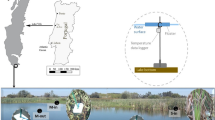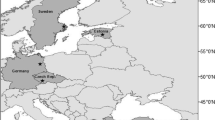Abstract
Recent studies have indicated that temporal mismatches between interacting populations may be caused by consequences of global warming, for example rising spring temperatures. However, little is known about the impact of spatial temperature gradients, their vulnerability to global warming, and their importance for interacting populations. Here, we studied the vertical distribution of two planktivorous fish species (Coregonus spp.) and their zooplankton prey in the deep, oligotrophic Lake Stechlin (Germany). The night-time vertical centre of gravity both of the fish populations and of two of their prey groups, daphnids and copepods, were significantly correlated to the seasonally varying water temperature between March and December 2005. During the warmer months, fish and zooplankton occurred closer to the surface of the lake and experienced higher temperatures. The Coregonus populations differed significantly in their centre of gravity; hence, also, the temperature experienced by the populations was different. Likewise, daphnids and copepods occurred in different water depths and hence experienced different temperatures at least during the summer months. We conclude that any changes in the vertical temperature gradient of the lake as a result of potential future global warming may impact the two fish populations differently, and may shape interaction strength and timing between fish and their zooplankton prey.





Similar content being viewed by others
References
Axenrot T, Hansson S (2003) Predicting herring recruitment from young-of-the-year densities, spawning stock biomass, and climate. Limnol Oceanogr 48:1716–1720
Beaugrand G, Brander KM, Lindley JA, Souissi S, Reid PC (2003) Plankton effect on cod recruitment in the North Sea. Nature 426:661–664
Benndorf J, Kranich J, Mehner T, Wagner A (2001) Temperature impact on the midsummer decline of Daphnia galeata: an analysis of long-term data from the biomanipulated Bautzen reservoir (Germany). Freshw Biol 46:199–211
Burns CW, Mitchell SF (1980) Seasonal succession and vertical distribution of zooplankton in Lake Hayes and Lake Johnson. NZ J Mar Freshw Res 14:189–204
Casper J (1985) Lake Stechlin - a temperate oligotrophic lake. Monogr Biol 58:883
Chavez FP, Ryan S, Lluch-Cota SE, Niquen M (2003) From anchovies to sardines and back: multidecadal change in the Pacific Ocean. Science 299:217–222
Chouinard A, Bernatchez L (1998) A study of trophic niche partitioning between larval populations of reproductively isolated whitefish (Coregonus sp.) ecotypes. J Fish Biol 53:1231–1242
Cushing DH (1995) The long-term relationship between zooplankton and fish. ICES J Mar Sci 52:611–626
DeStasio BT, Hill DK, Kleinhans JM, Nibbelink NP, Magnuson JJ (1996) Potential effects of global climate change on small north- temperate lakes: physics, fish, and plankton. Limnol Oceanogr 41:1136–1149
Edwards M, Richardson AJ (2004) Impact of climate change on marine pelagic phenology and trophic mismatch. Nature 430:881–884
Gerten D, Adrian R (2000) Climate-driven changes in spring plankton dynamics and the sensitivity of shallow polymictic lakes to the North Atlantic oscillation. Limnol Oceanogr 45:1058–1066
Gerten D, Adrian R (2002) Effects of climate warming, north atlantic oscillation, and El Nino-southern oscillation on thermal conditions and plankton dynamics in northern hemisphere lakes. Sci World J 2:586–606
Hamrin SF (1986) Vertical distribution and habitat partitioning between different size classes of vendace, Coregonus albula, in thermally stratified lakes. Can J Fish Aquat Sci 43:1617–1625
Harrington R, Woiwod I, Sparks T (1999) Climate change and trophic interactions. Trends Ecol Evol 14:146–150
Hays GC, Richardson AJ, Robinson C (2005) Climate change and marine plankton. Trends Ecol Evol 20:337–344
Kasprzak P, Schwabe W (1987) Some observations on the diurnal vertical migration of crustacean zooplankton in a stratified oligotrophic clear water lake (Lake Stechlin, GDR). Limnologica 18:297–311
Kasprzak P, Reese C, Koschel R, Schulz M, Hambaryan L, Mathes J (2005) Habitat characteristics of Eurytemora lacustris (POPPE, 1887) (Copepoda, Calanoida): the role of lake depth, temperature, oxygen concentration and light intensity. Int Rev Hydrobiol 90:292–309
Kessler K, Lampert W (2004) Depth distribution of Daphnia in response to a deep-water algal maximum: the effect of body size and temperature gradient. Freshw Biol 49:392–401
Koschel R, Adams DD (2003) Lake Stechlin: an approach to understanding an oligotrophic lowland lake. Schweizerbart, Stuttgart
Lampert W, Sommer U (1999) Limnoökologie. Thieme, Stuttgart
MacKenzie BR, Köster FW (2004) Fish production and climate: sprat in the Baltic Sea. Ecology 85:784–794
Magnuson JJ, Webster KE, Assel RA, Bowser CJ, Dillon PJ, Eaton JG, Evans HE, Fee EJ, Hall RI, Mortsch LR, Schindler DW, Quinn FH (1997) Potential effects of climate changes on aquatic systems: Laurentian Great Lakes and Precambrian shield region. Hydrol Processes 11:825–871
Marcogliese DJ, Esch GW (1992) Alterations of vertical distribution and migration of zooplankton in relation to temperature. Am Midl Nat 128:139–155
Mehner T (2000) Influence of spring water warming on predation rate of underyearling fish on Daphnia—a deterministic simulation approach. Freshw Biol 45:253–265
Mehner T (2006) Individual variability of diel vertical migrations in vendace (Coregonus albula) explored by stationary vertical hydroacoustics. Ecol Freshw Fish 15:146–153
Mehner T, Schulz M (2002) Monthly variability of hydroacoustic fish stock estimates in a deep lake and its correlation to gillnet catches. J Fish Biol 61:1109–1121
Mehner T, Hölker F, Kasprzak P (2005) Spatial and temporal heterogeneity of trophic variables in a deep lake as reflected by repeated singular samplings. Oikos 108:401–409
Northcote TG, Rundberg H (1970) Spatial distribution of pelagic fishes in Lambarfjarden (Malaren, Sweeden) with particular reference to interaction between Coregonus albula and Osmerus eperlanus. Rep Inst Freshw Res Drottningholm 50:133–167
Parker HH, Noonburg EG, Nisbet RM (2001) Models of alternative life-history strategies, population structure and potential speciation in salmonid fish stocks. J Anim Ecol 70:260–272
Platt T, Fuentes-Yaco C, Frank KT (2003) Spring algal bloom and larval fish survival. Nature 423:398–399
Riget F, Jeppesen E, Landkildehus F, Lauridsen TL, Geertz-Hansen P, Christoffersen K, Sparholt H (2000) Landlocked Arctic charr (Salvelinus alpinus) population structure and lake morphometry in Greenland—is there a connection? Polar Biol 23:550–558
Schulz M, Freyhof J (2003) Coregonus fontanae, a new spring-spawning cisco from Lake Stechlin, northern Germany (Salmoniformes: Coregonidae). Ichthyol Explor Freshw 14:209–216
Schulz M, Kasprzak P, Anwand K, Mehner T (2003) Diet composition and food preference of vendace (Coregonus albula (L.)) in response to seasonal zooplankton succession in Lake Stechlin. Arch Hydrobiol Spec Issues Adv Limnol 58:215–226
Schulz M, Freyhof J, Saint-Laurent R, Ostbye K, Mehner T, Bernatchez L (2006) Evidence for independent origin of two spring-spawning ciscoes in Germany (Salmoniformes: Coregonidae). J Fish Biol 68(Suppl A):119–135
Sokal RR, Rohlf FJ (1995) Biometry, 3rd edn. Freeman, New York
Sommer U, Gliwicz ZM, Lampert W, Duncan A (1986) The PEG-model of seasonal succession of planktonic events in fresh waters. Arch Hydrobiol 106:433–471
Straile D (2002) North Atlantic Oscillation synchronizes food-web interactions in central European lakes. Proc R Soc Lond B 269:391–395
Straile D, Livingston DM, Weyhenmeyer GA, George DG (2003) The response of freshwater ecosystems to climate variability associated with the North Atlantic oscillation. In: Hurrell JW, Kushnir Y, Ottersen G, Visbeck M (eds) The North Atlantic oscillation: climatic significance and environmental impact AGU geophysical monograph series, Washington, pp 263–279
Sydänoja A, Helminen H, Sarvala J (1995) Vertical migrations of vendace (Coregonus albula) in a thermally unstratified lake (Pyhäjärvi, SW Finland). Arch Hydrobiol Spec Issues Adv Limnol 46:277–286
Thackeray SJ, George DG, Jones RI, Winfield IJ (2005) Vertical heterogeneity in zooplankton community structure: a variance partitioning approach. Arch Hydrobiol 164:257–275
Thackeray SJ, George DG, Jones RI, Winfield IJ (2006) Statistical quantification of the effect of thermal stratification on patterns of dispersion in a freshwater zooplankton community. Aquat Ecol 40:23–32
Visser ME, Both C (2005) Shifts in phenology due to global climate change: the need for a yardstick. Proc R Soc Lond B 272:2561–2569
Wagner AR, Seitz A (1992) Qualitative and quantitative investigations on the cladoceran zooplankton of oligotrophic maar lakes. Arch Hydrobiol Spec Issues Adv Limnol 38:171–182
Winder M, Schindler DE (2004) Climate change uncouples trophic interactions in an aquatic ecosystem. Ecology 85:2100–2106
Winder M, Buergi HR, Spaak P (2003) Seasonal vertical distribution of phytoplankton and copepod species in a high-mountain lake. Arch Hydrobiol 158:197–213
Acknowledgments
Many thanks to C. Helms, A. Türck, M. Sachtleben and R. Degebrodt who helped during sampling, and to K. Kalies who counted the zooplankton samples. The study was financially supported by the Aquashift priority program of the German Research Foundation (DFG, project no. Me 1686/5-1).
Author information
Authors and Affiliations
Corresponding author
Additional information
Communicated by Ulrich Sommer.
Priority programme of the German Research Foundation—contribution 9.
Rights and permissions
About this article
Cite this article
Helland, I.P., Freyhof, J., Kasprzak, P. et al. Temperature sensitivity of vertical distributions of zooplankton and planktivorous fish in a stratified lake. Oecologia 151, 322–330 (2007). https://doi.org/10.1007/s00442-006-0541-x
Received:
Accepted:
Published:
Issue Date:
DOI: https://doi.org/10.1007/s00442-006-0541-x




